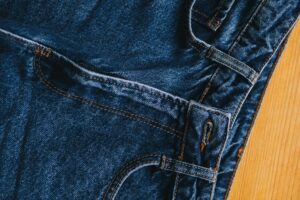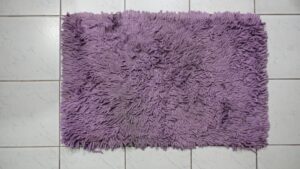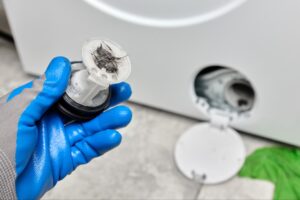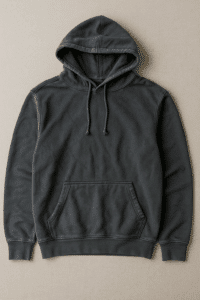How to Get Paint Out of a Shirt
You just discovered a splash of paint on your favorite shirt – now what? Paint is notoriously one of the hardest stains to get out of fabric, but don’t lose hope. With the right approach, you can often remove paint from a shirt and save it from the rag pile. The key is knowing what kind of paint you’re dealing with and treating the stain properly, whether it’s fresh or has already dried. This guide will walk you through how to get paint out of a shirt, covering different paint types (from kid-friendly acrylics to stubborn oil-based enamels), tips for various fabrics, and what to do if that stain just won’t budge.

Before we dive in, remember some general stain-fighting rules. Gently scrape or blot away any excess paint without rubbing it deeper into the fibers. If the paint is wet, try to keep it from drying out – and if it’s dry, you’ll need to loosen it up. Always spot test any cleaner (like alcohol or thinner) on a hidden part of the fabric first to ensure it won’t cause damage or discoloration. And never machine-dry a paint-stained shirt until the stain is completely gone – heat can set paint permanently into the fabric.
Here’s what you may need to tackle paint stains:
- Dull scraper: Use a spoon or dull knife to lift or chip off dried paint.
- Absorbent cloths or paper towels: For blotting stains and placing behind the fabric to catch paint residue.
- Dish soap or laundry detergent: Mild cleaners to break down water-based paints and aid in pretreating.
- Rubbing alcohol (isopropyl alcohol): A handy solvent for dissolving dried acrylic and latex paint.
- Nail polish remover (acetone or non-acetone): Helps with oil-based or spray paint; use carefully on durable fabrics.
- Paint thinner or turpentine: Strong solvents for oil-based paint stains (use with caution and ventilation).
- Soft brush or old toothbrush: To gently scrub stain treatments into the fabric.
- Bucket, sink, or basin of water: For rinsing and soaking the garment as you treat the stain.
Fresh vs. Dried Paint Stains: Act Fast vs. Be Patient
Fresh paint: If the paint stain is still wet, quick action is your best friend. Wet paint is much easier to remove because it hasn’t fully set into the fibers. As soon as you notice it, scoop or blot up excess paint gently with a cloth or paper towel (don’t smear it). For water-based paints like acrylic or latex, run the stained area under warm running water from the back side of the fabric to flush out as much paint as possible. (Even appliance makers like Whirlpool recommend rinsing a fresh paint stain from the reverse side with water.) Apply a bit of dish soap or laundry detergent to the remaining stain, and keep lightly rubbing the fabric together or use a soft brush to help lift the paint. Rinse and repeat a few times until you’ve removed as much of the color as you can. The sooner you treat it, the better your chances of completely removing the paint.
Dried paint: Dried paint on clothing is tougher – there’s no sugar-coating it. Once paint dries, it binds with the fabric and may require more elbow grease and stronger cleaners. Start by scraping off any crusty dried paint gently with a dull knife or the edge of a credit card. Don’t pull too hard to avoid ripping the fibers. After removing the hardened excess, you’ll likely need a solvent (like rubbing alcohol for water-based paints or paint thinner for oil-based paints) to re-soften the paint. Expect to spend more time on a dried stain and possibly repeat treatments. Be patient and persistent, and remember to avoid tossing the item in the dryer between attempts. It might take a few cycles of treatment and rinsing to break down a dried paint stain, but with careful work, you can often get it out.
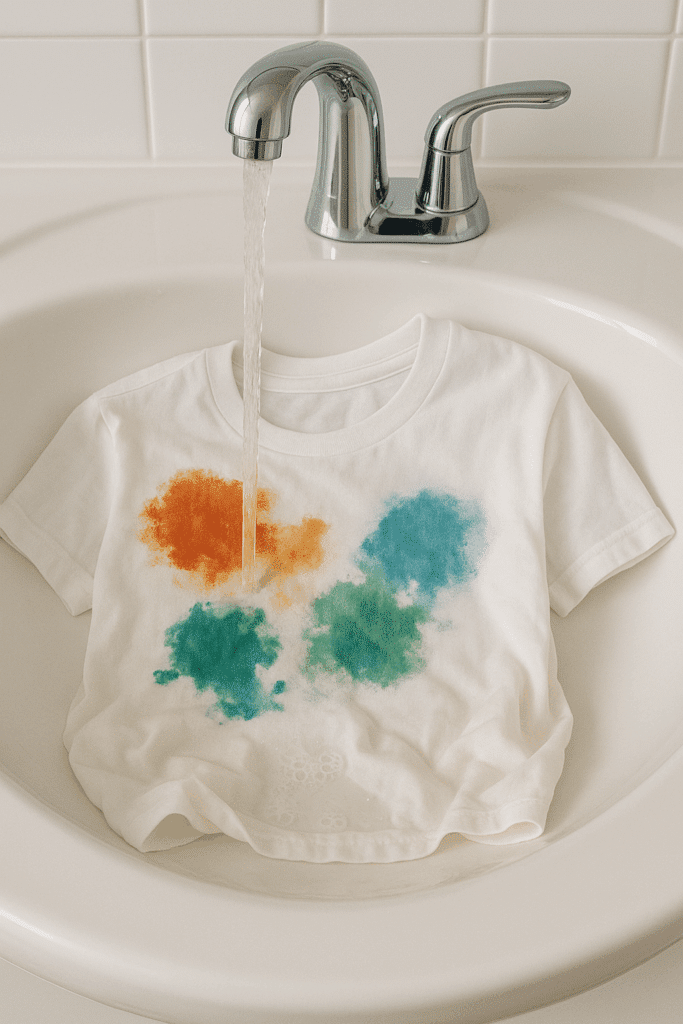
How to Remove Acrylic Paint from a Shirt
Acrylic paints are common in arts and crafts – they’re water-based and often labeled “washable,” but once they dry, they can still put up a fight. The good news is acrylic paint is usually easier to remove than oil paint if you catch it in time. Here’s how to tackle an acrylic paint stain:
- Step 1: Act quickly if possible. If the acrylic paint is still wet, blot up or rinse off as much as you can immediately. Use a paper towel or clean rag to dab (don’t rub) the excess paint. Rinse the spot from the back under warm water to push out more paint.
- Step 2: Pretreat with soap. Work a small amount of liquid dish soap or laundry detergent into the stain. Gently scrub the area with your fingers or a soft toothbrush. This helps break up the paint’s pigments. Rinse with warm water and see if the stain is fading.
- Step 3: Apply rubbing alcohol. For dried or stubborn acrylic paint, rubbing alcohol is your MVP. Soak a cotton ball or clean cloth with isopropyl alcohol and dab it onto the stain. You should start to see the paint transferring to the cloth as the alcohol breaks it down. Let the alcohol sit on the stain for a minute or two, then blot again. (This method is so effective that Tide’s stain experts specifically recommend isopropyl alcohol for dried acrylic paint.)
- Step 4: Rinse and repeat. Rinse the area thoroughly with warm water. Check the stain. If there’s still paint, reapply a bit more alcohol or soap and repeat the process. It might take a couple of rounds for all the paint to come out, especially if it was a large or thick blob.
- Step 5: Wash and dry (air dry first!). Once you’ve removed most or all of the paint, toss the shirt in the washing machine. Use the warmest water setting that’s safe for the fabric (check the care label) and your regular detergent. After washing, let the shirt air dry and inspect the spot. Acrylic paint should be gone; if you see any lingering color, avoid machine drying and try another round of treatment. If it’s all clear, you can tumble dry on your next laundry day.
How to Remove Latex Paint from Clothes
Latex paint (often used for house paint on walls) is another water-based paint, similar to acrylic but sometimes formulated a bit differently. If you get latex wall paint on your clothing, treat it like an acrylic paint stain with a few tweaks. Here’s the game plan for latex paint:
- Step 1: Scoop and blot excess. If the latex paint is still wet, gently scrape off any globs with a dull edge and blot the area with a cloth. Wet latex paint can sometimes be peeled off if there’s a thick layer – but be careful not to spread it.
- Step 2: Rinse with water. Run the stain under cool or lukewarm water from the back side of the fabric to flush out as much paint as you can. Latex paint is water-based, so a lot of it can wash out if you act fast. Keep the water flowing until it seems like no more paint is coming out.
- Step 3: Work in dish soap. Apply a good squirt of dish soap or liquid laundry detergent to the remaining stain. Rub the fabric together or use a soft brush to work the soap into the paint. You’ll likely see paint loosening and mixing into the soapy lather. Rinse and repeat this scrubbing a couple of times.
- Step 4: Use rubbing alcohol on the stain. If the latex paint dried before you could treat it, or if a stain remains, dab on some rubbing alcohol just like with acrylic. Blot and tamp the area with an alcohol-soaked cloth. This will help dissolve paint that soap and water didn’t get. You may notice bits of paint coming off onto your cloth.
- Step 5: Try a deeper soak (for stubborn stains). If you’re still seeing paint, you can employ a stronger home remedy. HGTV’s experts recommend soaking the garment in a solution of two parts ammonia, two parts white vinegar, and one part salt (for example, 1 cup ammonia + 1 cup vinegar + 1/2 cup salt) overnight. This mixture can help break down dried latex paint. After soaking, rinse the shirt thoroughly.
- Step 6: Wash the garment. Wash the shirt in the washing machine on a normal cycle with the hottest water temperature safe for the fabric. Use your regular detergent. The wash will remove any remaining paint fragments and the smell of vinegar or ammonia. Once again, air dry the shirt after washing and check that the paint stain is completely gone before using the dryer.
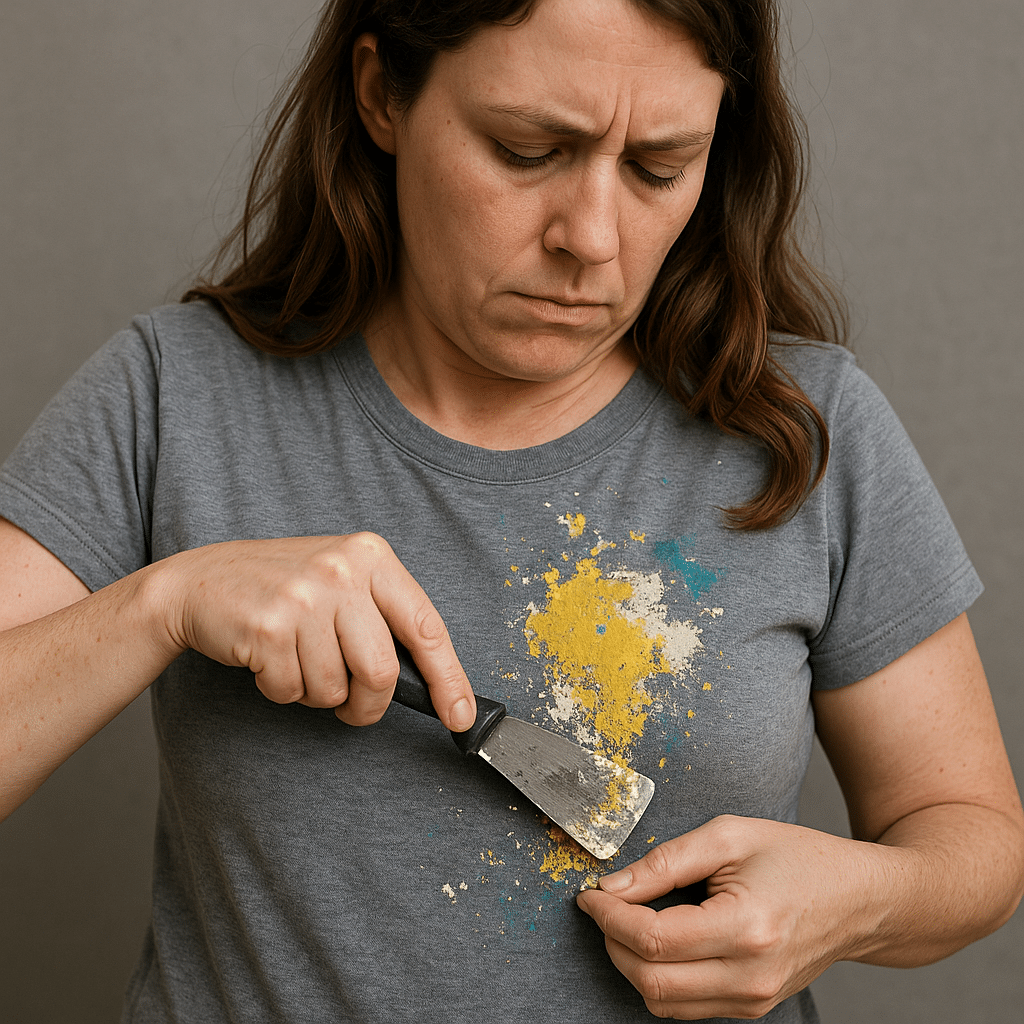
How to Remove Oil-Based Paint from Clothes
Oil-based paints (like alkyd enamels, artist oil paints, or some wood paints) are the trickiest of the bunch. Since they aren’t water-soluble, water alone won’t do much – you’ll need solvents to tackle these. The process is a bit more involved, but you can often rescue the garment. Here’s how to deal with oil-based paint stains:
- Step 1: Check the paint can or label if possible. If you know the type of paint, see what solvent is recommended for cleanup (for example, mineral spirits, turpentine, etc.). It’s best to use the thinner specified for that paint. If you’re unsure, turpentine or mineral spirits (paint thinner) are common choices that work on many oil paints.
- Step 2: Blot with solvent from the back. Place a few paper towels or an old cloth under the stained area (on the backside of the stain). Dip a clean rag or cotton ball in paint thinner or turpentine. Working from the back of the fabric, dab the solvent onto the paint stain. You should see the paint start to soften and transfer to the absorbent material underneath. Keep moving the underlying cloth to a clean spot as it absorbs paint. Gently blot – don’t aggressively rub, as you don’t want to spread the stain.
- Step 3: Continue until no more paint comes out. Reapply solvent and blot repeatedly. It may take several rounds until you’re not seeing any more paint being lifted out. Be patient and use fresh paper towels or cloths as the paint transfers. This step may take some time for thick or old stains.
- Step 4: Rinse and apply dish soap. Once you’ve removed as much paint as possible with the solvent, rinse the area thoroughly in warm running water to flush out the chemicals and remaining paint. Then, massage a hearty dose of dish soap or heavy-duty laundry detergent into the area. The soap will help cut through the oily residue from both the paint and the solvent. Work it in and let it sit for 5–10 minutes.
- Step 5: Wash in hot water. Wash the shirt separately on the hottest water setting safe for the fabric (check the care tag). Use a strong detergent. Hot water and detergent will help remove any last traces of oil. After washing, check the stain spot. If a hint of paint still lingers, avoid drying and consider repeating the solvent and washing process.
- Step 6: Air dry and inspect. Let the shirt air dry and then inspect it in good light. Oil paint is stubborn, so you want to be sure it’s gone. If it’s gone – great! If a small spot remains, you might try a bit more targeted solvent work or take the garment to a professional cleaner. Remember to never put clothes that still smell like paint thinner into a hot dryer (or you risk a fire). Ensure all solvent is rinsed out and the smell is gone before using the dryer.
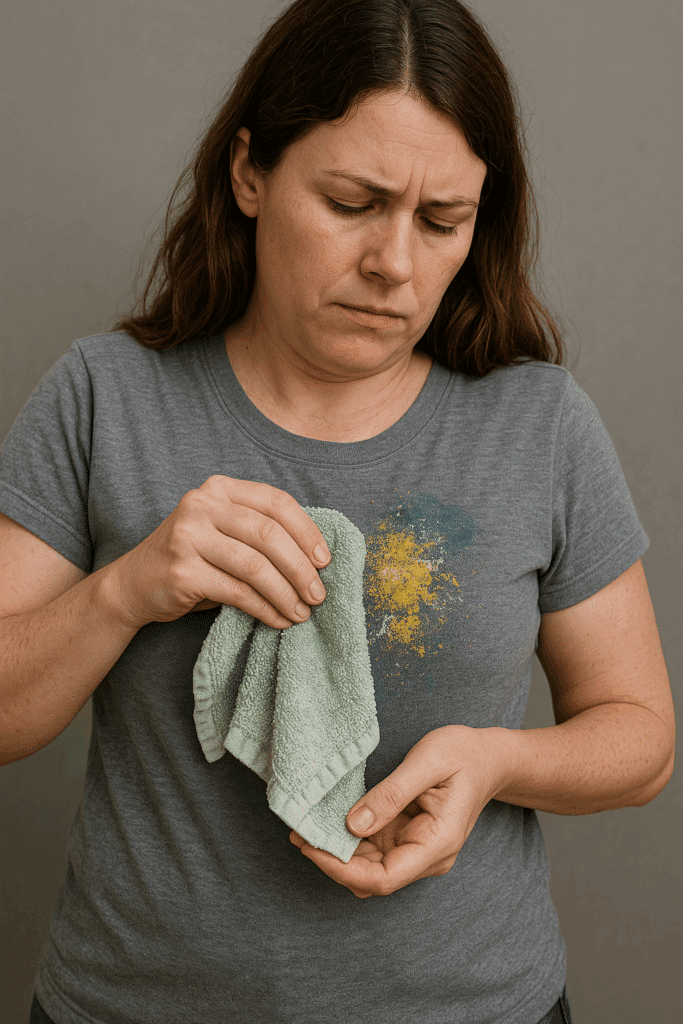
How to Remove Spray Paint from Clothes
Spray paint can be either latex or oil-based depending on the type, and it often dries fast in a fine mist. Getting spray paint on a shirt (say from a DIY project gone awry) is frustrating but not necessarily a lost cause. The approach for spray paint is similar to other paints, with an emphasis on solvents and careful blotting. Here’s what to do:
- Step 1: Shake off or scrape excess. If the spray paint left a crusty layer (sometimes heavy spray can do that), gently scrape off any flakes with a fingernail or dull tool. Often, spray paint is a light mist, so you might not have much to scrape.
- Step 2: Blot with alcohol. Place an old towel or rag behind the stained area to catch any color. Moisten a clean cloth with rubbing alcohol and start dabbing the spray paint stain. You should see color coming off onto your cloth. Work from the outside of the spray paint area toward the center to avoid spreading the stain. Keep repositioning your under-towel to a clean spot as paint transfers.
- Step 3: Let it soak a bit. For stubborn spray paint, you can pour a little rubbing alcohol directly on the fabric or let a cloth soaked in alcohol sit on top of the stain for a minute or two. This gives the solvent time to penetrate the paint. Again, blot to lift out the dissolved paint. Be patient and avoid scrubbing aggressively.
- Step 4: Try nail polish remover for remaining spots. If traces of paint are still clinging on, you can use a small amount of acetone-based nail polish remover. Do this only on fabrics you know can handle it (acetone can damage materials like acetate or rayon). Dab the acetone on the remaining paint, and it should break it down further. As always, test first and use sparingly. If you notice any fabric damage or color coming off, switch back to rubbing alcohol – it’s gentler.
- Step 5: Wash the shirt. Rinse the area well to remove all solvent, then wash the shirt in the machine with detergent. Use a warm water setting. It’s a good idea to wash this item by itself or with some old towels, in case any paint particles remain. After washing, let it air dry.
- Step 6: Check and repeat if needed. Examine the air-dried fabric. Spray paint, especially lighter overspray, often comes out completely after this treatment. If you still see a shadow of paint, you can repeat the alcohol/acetone treatment for another round. Do not put it in the dryer until you’re satisfied the stain is gone.
Tips for Different Fabrics: Cotton, Synthetics, and Denim
Not all shirts are created equal when it comes to stain removal. The fabric type can influence how you approach a paint stain:
- Cotton: Most cotton shirts (t-shirts, button-downs, etc.) can handle warm water and a bit of scrubbing. Cotton fibers are fairly durable, so you can apply elbow grease when scrubbing out paint. They also tolerate solvents like rubbing alcohol well. If the cotton shirt is white, you have the option of using a mild bleach solution as a last resort to remove any lingering stain after you’ve tried other methods (just be careful, as bleach can yellow some whites). Colored cottons should be spot-tested with solvents to ensure the dye doesn’t fade.
- Synthetics (Polyester, Nylon, etc.): Synthetic fabrics can be a mixed bag. On one hand, paints might not penetrate as deeply into some synthetic fibers (like polyester) because they’re slick, but on the other hand, oil-based paints can cling to them. Use gentle scrubbing on synthetics, since they can pill or fray with too much force. Avoid very harsh chemicals on delicate synthetics – for example, acetone can actually melt fabrics that contain acetate. Rubbing alcohol is usually safe on polyesters and most blends, but always test first. Also, use cooler water on synthetics if you’re unsure, as high heat can sometimes warp them.
- Denim: Denim is a tough cotton twill, so it can handle vigorous treatment. If you get paint on your jeans or a denim jacket, you can scrub a bit harder with a brush to get into the thick weave. Denim can also withstand hotter wash water (again, check the label in case of stretch denim with elastane). One thing to watch: intense scrubbing or solvents might remove some of the dye from denim along with the paint, leaving a lighter spot. If that happens, you can consider it added character (a little paint speck can look like part of the distressed style), or you might even dye the spot back with fabric dye or a marker. But generally, denim will forgive you for going hard at a paint stain.

Hand Rinsing vs. Machine Washing
When dealing with paint stains, you might wonder when to hand wash/rinse and when to throw the item in the washing machine. The answer is: do both, but in the right order. Always tackle the stain by hand first. Rinsing and scrubbing a paint stain manually is crucial to get the majority of the paint out of the fabric. If you were to toss a painted shirt straight into the washer without pre-treating, chances are the paint would just get redistributed or remain stuck on the fabric (and you don’t want paint flakes in your washing machine either!). By hand rinsing and treating first, you remove or loosen most of the paint.
Once you’ve done the legwork by hand and the stain is significantly faded or gone, then a machine wash will effectively clean the garment and any residue. Use a normal or heavy-duty cycle as needed, with the appropriate water temperature. It’s wise to wash the stained item by itself or with a few old towels the first time, in case any paint particles are still floating around. After the wash, always check the stained area before moving it to the dryer. If you still see paint, go back to hand treatment for another round. If it looks clean, you’re clear to dry and wear the shirt again.
Troubleshooting: When Paint Stains Won’t Come Out
Sometimes, despite your best efforts, that paint spot might still be faintly there or the area might have a slight discoloration. Don’t feel bad – some paint pigments are incredibly persistent. If you’ve repeated the cleaning steps and the stain has only faded but not disappeared, you have a few options. One approach is to try a different method or product: for example, if you’ve been using alcohol and it’s only half-gone, try a commercial stain remover spray or a bit of hydrogen peroxide (for light-colored fabrics) on the remaining stain. Just remember to rinse out any chemicals thoroughly.
If the fabric color looks lightened or there’s a “ring” where the paint was, it could be due to the solvent removing some dye or the paint leaving a residue. To fix a light discoloration, sometimes washing the entire garment can even out the color difference. You could also gently rub the surrounding area with a cloth dampened with alcohol to blend it if the fabric is colorfast. In some cases, a fabric dye or permanent marker in a matching color can touch up a small faded spot (this works best on dark items like black shirts or jeans).
At a certain point, it’s completely fine to throw in the towel on DIY removal. Paint is one of the top hard-to-remove stains, and professional help can be a real time-saver. A good laundry service or dry cleaner has special solvents and machines that can sometimes work wonders on set-in stains. If you’re in doubt or don’t want to risk damaging your shirt further, consider taking it to the pros.
In fact, if you’re in Chicago, you can bring your item to us at Spincycle. We offer a convenient wash & fold service where our team will handle the stain treatment and washing for you. You could also use our self-service laundromat – our machines are large and effective, and we have attendants who can offer stain-fighting advice on the spot.
For a deep sanitation boost (great for really stubborn grime or odors that sometimes come with old paint), we even have an ozone cleaning system that cleans and sanitizes clothes without harsh chemicals. And if you’re too busy to come by, no worries – schedule a laundry pickup and delivery and let us handle the dirty work. Sometimes the easiest way to get a paint-stained shirt back to perfection is to let a professional service give it a go.

With a bit of effort (and maybe a little help from stain-fighting friends), that paint stain doesn’t stand a chance. Remember to act fast on fresh spills, be patient with dried stains, and always double-check the care instructions on your shirt when using any cleaning agents or heat. Soon, your shirt will be paint-free and ready to wear – like the mishap never even happened!

